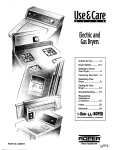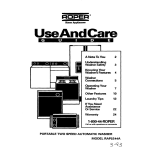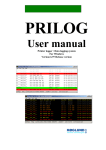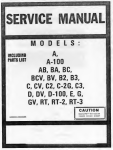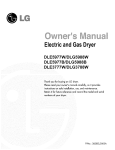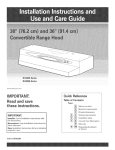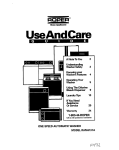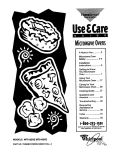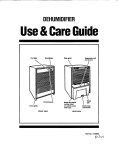Download Whirlpool BYCD3722W0 User's Manual
Transcript
Use&Care Electric and Gas Dryers A Note to You .. . . .. . . . .. . 2 Dryer Safety .. . .. . . . . .. . . . 3 Parts and Features . . . 5 Checking Your Vent . .. 6 Operating Your Dryer .. . . . .. . .. . . . .. . . . . .. . .. . 8 Caring for Your Dryer .. . . . . .. . .. . . . .. . .. .. . . 12 Troubleshooting .. . .. . 15 Requesting Assistance or Service .. . . .. . . . .. . . . .. 17 Index .. . .. . . . . . . .. . .. .. . .. . . 18 Warranty .. . . . .. . .. . . . . .. . 20 I-8001253=1301 Call us with questions PART NO. 3408078 or comments. ANomYou Thankyoufor buyinpthis appliance. You have purchased a quality world-class appliance. To ensure that you enjoy years of trouble-free operation, we developed this Use and Care Guide. It is full of valuable information about how to operate and maintain your appliance properly and safely. Please read it carefully. Also, complete and mail the Ownership Registration Card provided with your appliance. The card helps us notify you about any new information on your appliance. Pleaserecordyourmodel’sinformation. Whenever you call to request service for your appliante, you need to know your complete model number and serial number. You can find this information on the model and serial number label/plate (see the diagram on the “Parts and Features” section for the location of the label). Also, record the other information shown in the next column. Model Number Serial Number Purchase Date Dealer Name Dealer Address Dealer Phone Keepthis bookandthe salesslip togetherin a safeplacefor future reference. I 2 OurConsumer AssistanceCenternumberis toll free. 1-800-253-1301 DKYERSAFEIY Yoursafetyandthe safetyof othersis veryimportant. We have provided many important safety messages in this manual and on your appliance. Always read and obey all safety messages. This is the safety alert symbol. This symbol alerts you to hazards that can kill or hurt you and others. All safety messages will be preceded by the safety alert symbol and the word “DANGER” or “WARNING.” These words mean: You will be killed or seriously injured If you don’t follow instructions. You can be killed or seriously injured if you don’t follow instructions. All safety messages will identify the hazard, tell you how to reduce the chance of injury, and tell you what can happen if the instructions are not followed. WARNING: For your safety the information in this manual must be followed to minimize the risk of fire or explosion or to prevent property damage, personal injury or death. \ - Do not store or use gasoline or other flammable of this or any other appliance. vapors and liquids in the vicinity -WHAT TO DO IF YOU SMELL GAS l Do not try to light any appliance. l Do not touch any electrical switch; do not use any phone in your building. l Clear the room, building or area of all occupants. l Immediately call your gas supplier from a neighbor’s phone. Follow the gas supplier’s instructions. l If you cannot reach your gas supplier, call the fire department. - Installation and service or the gas supplier. must be performed by a qualified installer, service agency continued on next page 3 IMPORTANT SAFETY INSTRUCTIONS WARNING - To reduce the risk of fire, electric shock, or injury to persons when using the dryer, follow basic precautions, including the following: 0 Read all instructions before using the dryer. 0 Do not dry articles that have been previously cleaned in, washed in, soaked in, or spotted with gasoline, dry-cleaning solvents, other flammable, or explosive substances as they give off vapors that could ignite or explode. 0 Do not allow children to play on or in the dryer. Close supervision of children is necessary when the dryer is used near children. 0 Before the dryer is removed from service or discarded, remove the door to the drying compartment. 0 Do not reach into the dryer if the drum is moving. 0 Do not install or store the dryer where it will be exposed to the weather. 0 Do not tamper with controls. 0 Do not repair or replace any part of the dryer or attempt any servicing unless specifically recommended in this Use and Care Guide or in published user-repair instructions that you understand and have the skills to carry out. l Do not use fabric softeners or products to eliminate static unless recommended by the manufacturer of the fabric softener or product. 0 Do not use heat to dry articles containing foam rubber or similarly textured rubber-like materials. 0 Clean lint screen before or after each load. 0 Keep area around the exhaust opening and adjacent surrounding areas free from the accumulation of lint, dust, and dirt. 0 The interior of the dryer and exhaust vent should be cleaned periodically by qualified service personnel. l See Installation Instructions for grounding requirements. - SAVE THESE INSTRUCTIONS - hKMND blMS The parts and features of your dryer are illustrated on this page. Become familiar with all parts and features before using your dryer. Page references are included next to some features. Refer to those pages for more information about the features. Startbutton (P- 8) Lint screen (P- 12) Model and serial number label @- 2) I I - Dryer drum @- 13) Exhaust grill Small side-swing /door Additionalfeaturesyour dryermayhave: End of cycle signal selector (p. 8) Drum light (p. 14) CHECKINGYOURVENT Your dryer must be properly installed and vented to achieve maximum drying efficiency and shorten drying times. Use the minimum recommended installation clearances (found in your Installation Instructions) to avoid blocking the flow of combustion and ventilation air. Install your dryer in a well-ventilated room where the temperature is always above 45°F (7°C). Also make sure that your dryer is leveled. Refer to your Installation Instructions for more information. VENIINC 2. Use a 4-inch exhaust hood. Smaller hoods increase drying times. f ’ f A Fire Hazard Use a heavy metal vent. Do not use a plastic vent. Do not use a metal foil vent. Failure to follow these instructions result in death or fire. can If the dryer is not properly installed and vented, it will not be covered under the warranty. NOTE: Service calls caused by improper venting will be paid for by the customer, whether it was a paid installation or self-installed. For paid installation, call the company that installed the vent for adjustment. length requirements 6 or flexible metal foil vent. Use 4-inch heavy metal or flexible metal vent. Do not kink or crush flexible metal vent. It must be completely extended to allow adequate exhaust air to flow. Check vent after installation. Refer to your Installation Instructions for proper of vent. 3. The exhaust vent can be routed up, down, left, right, or straight out the back of the dryer. Space requirements are listed in your Installation Instructions. 4. Use the straightest path possible when routing the exhaust vent. Avoid 90” turns, if possible. Allow room when using elbows or making turns. Bend vent gradually to avoid kinking. 5. Use duct tape to seal all joints. Do not use screws to secure vent. Lint may catch on screws. 6. Clean exhaust vent periodically, depending on use, but at least every 2 years, or when installing your dryer in a new location. 0 Disconnect vent from the dryer and clean one section at a time until you reach the exhaust hood. 0 Use the hose attachment on your vacuum, or a pole or wire with a feather duster or rag attached, to clean out lint. l Be sure the flapper on the outside end of vent moves freely. 0 When cleaning is complete, be sure to follow the Installation Instructions supplied with your dryer for final product check. 7 OPEIWINCYOURDKVER To get the best dryer results possible, you must use your dryer correctly. This section tells you how to use your dryer properly and efficiently. MTINC YOUR DRYER Explosion Hazard Keep flammable materials and vapors, such as gasoline, away from dryer. Do not dry anything that has ever had anything flammable on It (even after washing). Failure to follow these Instructions can result in death, explosion, or fire. BIefore using your dryer, wipe the dryer drum with a d;amp cloth to remove dust from storing and shipping. If your dryer has a Features Guide, remove it and Place it with this Use and Care Guide. 1 . Load clothes loosely into the dryer and close the Idoor. Do not pack the dryer; allow space for clothes to tumble freely. 2 8 lnob to the recommended cycle for the type of load being dried, as described in “Cycle descriptions” later in this section. l Use the Energy Preferred Automatic Setting (*) to dry most loads. NOTE: On some models, l the Temperature selector is part of the Cycle Control Knob. Fire Hazard No washer can completely remove oil. Do not dry anything that has ever had any type of oil on It (including cooking oils). Items containing foam, rubber, or plastic must be dried on a clothesline or by using an Air Cycle. Failure to follow these instructions can result in death or fire. 3. If your dryer has a Temperature selector, set it to the recommended setting for the type of fabric being dried. The cycle descriptions on the following pages include temperature setting suggestions. 4. (OPTIONAL STEP) If your dryer has a Cycle Signal (End of Cycle Signal) selector, set the selector to On if you want the dryer to sound a signal when a cycle is finished. l The signal is helpful when you are drying permanent press, synthetics, and other items that should be removed from the dryer as soon as it stops. l On some models, the End of Cycle Signal is part of the Start button. 5. Push the Start Button. NOTE: Your dryer stops automatically cycle ends. when a STAKING YOUR DRYER (CONT.) Stoppingandrestartinpyour dryer To restart your dryer: You can stop your dryer anytime during a cycle. Close the door, select a new cycle and temperature (if desired), and push the Start button. To stop your dryer: Open the dryer door or turn the Cycle Control Knob to off. NOTE: The Cycle Control Knob should point to an Off area when the dryer is not in use. iEWINGMERIGHT MI ANDlWlPERATuRE SETTING The following pages describe the drying cycles on your dryer. The descriptions include suggested temperature settings and drying times for various loads. cycleandtemperaturetips 0 Make sure you have selected the correct cycle and temperature for your load. l Dry most loads using the Energy Preferred Automatic Setting (+). 0 Use the Fluff Air cycle, or line dry rubber, plastic, delicate, and heat-sensitive fabrics. l If some types of loads in the cycle descriptions on the following pages have more than one suggested temperature setting, choose the lowest setting available on your dryer. a The last few minutes of all cycles are without heat to make the load cooler to handle. Dryingtips 0 Always follow care label directions when they are available. l If you use fabric softener sheets, always use softener sheets that are labeled as dryer safe and follow package instructions carefully. 0 Remove the load from the dryer as soon as tumbling stops to reduce wrinkling. This is especially important for permanent press, knits, and synthetic fabrics. 9 Automaticcycle(s) Timedcycle(s) Use an Automatic Use a Timed drying cycle to complete drying if some items are damp after the Automatic cycle. A Timed drying cycle is also useful for: 0 Heavyweight and bulky items, such as bed spreads and work clothes, and large loads that require a long drying time. Set your dryer to a heat setting that matches the care label directions. 0 Lightweight items, such as lingerie, blouses, and knits that require a short drying time. Set your dryer for Low heat. 0 Drying time and temperature will depend on your dryer model. cycle to dry most loads. Depending on your model, the Automatic cycle uses either an electronic or automatic control that senses the moisture in the load and shuts off the dryer when the selected dryness is reached. The Cycle Control Knob L does not move until the load is almost dry. After the cool-down, the Knob automatically turns to an Off area and tumbling stops. 0 If the load is drier than you like, select a setting closer to Less Dry the next time you dry a similar load. 0 If the load is not as dry as you like, complete drying using a Timed cycle. Select a setting closer to Very Dry the next time you dry a similar load. Drying time with an Automatic cycle varies according to the type of fabric, size of load, and dryness setting. Your model may not have all heat settings listed. Some general guidelines are: 0 Use a high heat setting for drying heavyweight items, such as towels and work clothes. l Use a medium heat setting for drying mediumweight items, such as sheets, underwear, permanent press clothes, and some knits. 0 Use a low heat setting for drying lightweight items such as lingerie, blouses, dresses, and some knits. NOTE: If you have any questions about drying temperatures for various loads, refer to care label directions. 10 Fhff Air cycle (onsomemodels) Use the unheated Fluff Air cycle for items that require drying without heat. The chart on page 12 includes examples of items that require air drying. NOTE: If your model does not have the Fluff Air cycle, line dry heatsensitive items. The chart below includes examples of items that require drying without heat. Use the Fluff Air cycle, or place the items on a line or rack to air dry. Line dry bonded or laminated fabrics. l 0 Always follow care label directions available. when they are TYPE OF LOAD FLUFF AIR CYCLE* (minutes) RUBBER, PLASTIC, HEAT-SENSITIVE FABRICS Foam Rubber - Pillows, padded bras, stuffed toys l Make sure coverings are securely stitched. l 20 to 30 Shake and fluff pillows by hand several times during the Fluff Air cycle. Make sure pillows are completely dry. Foam rubber pillows take a long time to dry. Plastic - Shower curtains, tablecloths Rubber-backed rugs Olefin, Polypropylene, Sheer nylon l 20 to 30 40 to 50 10to20 ’ Reset cycle as needed to complete drying. 11 CARING HJRYOURDKVER Proper care of your dryer can extend its life and help your dryer operate efficiently. CEANIN~ MEurn sam Everyload cleaning ASneededcleaning The lint screen is located under a lid on top of the dryer. Clean it before each load. A screen blocked by lint can increase drying time. Laundry detergents and fabric softeners can cause a residue buildup on the lint screen. This buildup can cause longer drying times for your clothes, or cause the dryer to stop before your load is completely dry. You may be able to see this buildup, or the lint may be falling off the screen because it is clogged. Clean the lint screen with a nylon brush every six months or more frequently if it becomes clogged due to a residue buildup. To clean: 1. Open the lid and pull the lint screen towards you. Use the following method: 1. Wet both sides of lint screen with hot water. 2. Wet a nylon brush with hot water and liquid detergent; scrub lint screen with the brush to remove residue buildup. 2. Roll lint off the screen with your fingers. Do not rinse or wash screen to I remove lint. Wet lint is hard to remove. 3. Rinse screen with hot water. 4. Thoroughly dry lint screen with a clean towel; replace in dryer. 3. Push the lint screen firmly back into place and close the lid. IMPORTANT: 0 Do not run the dryer with the lint screen loose, damaged, blocked, or missing. Doing so can cause overheating and damage to both the dryer and fabrics. 0 Some towels made of synthetic fibers and natural fibers (polyester and cotton blends) may shed more lint than other towels, causing your dryer’s lint screen to fill up faster. Be sure to remove lint from the lint screen before and after drying new towels. 0 If lint falls into chute, double-check exhaust hood and clean out lint if necessary. 12 &ANlNCMEDRYER INlERlOR Garments which contain unstable dyes, such as denim blue jeans or brightly colored cotton items, may discolor the dryer interior. These stains are not harmful to your dryer and will not stain future loads of clothes. It is helpful to dry unstable dye items inside out to prevent dye transfer. NOTE: Even after cleaning, these stains may reappear when similar loads are dried. To clean dryer drum: 1. Make a paste with powdered laundry detergent and very warm water. 2. Apply paste to a soft cloth. Explosion Hazard Use nonflammable cleaner. Failure to do so can result In death, explosion, or fire. OR Apply a liquid, non-flammable household cleaner to the stained area and rub with a soft cloth until all excess dye is removed. 3. Wipe drum thoroughly with a damp cloth. 4. Tumble a load of clean cloths or towels to dry drum. 13 CHANCING TIME DRUM m The dryer light automatically turns on inside the dryer drum when you open the door. Fire Hazard Replace light bulb cover before operating dryer. Failure to do so can result In death or fire. TOchangedrumlight: 1. Unplug dryer or disconnect power. 2. Open the dryer door. Remove the light bulb fromthe back 1 cover wall of the dryer by turning the cover clockwise. r 3. Remove the light bulb by turning it counterclockwise. 4. Replace the bulb with a 40-watt appliance bulb only. 5. Replace the light bulb cover and lock in place by turning counterclockwise. 6. Plug in dryer or reconnect power. REMOVING ACCUMUlAlED UNTFROM INSIDE MEDRYER CABINETI I Lint can gather inside the dryer and be a fuel for fire. Lint should be removed every 2 years, or more often, depending on dryer usage. Cleaning should be done by a qualified person. I 14 1 Most laundering problems are easily solved if you understand the cause. Check the following list for common laundry problems and the next page for common dryer problems. If you need further assistance, see “Requesting Assistance or Service” on page 17. NOTE: In the following list, the most common laundry problems are listed first. :OMMON LAUNDRY PROBLEMS Problem ... Cause ... Slow drying or clothes still wet l Incorrect cycle or temperature setting selected. l Full or clogged lint screen. (See page 12.) a Exhaust vent clogged, restricted, or too long. (See pages 6 to 7 and Installation Instructions.) l Dryer located in room with temperature below 45°F (7°C). l Load too large and bulky to dry quickly. l Drying heavy fabrics (denim, towels) with light fabrics (synthetics, permanent press). 0 Fabric softener sheet blocking exhaust grill inside dryer drum. Lint 0 Full lint screen. (See page 12.) l Load not properly sorted. a Overdrying, especially synthetic fabrics that cause lint-attracting static electricity. 0 Load size too big or heavy. l Tissue or paper left in pockets. l Pilling (surface fuzz caused by normal wear and laundering) attracts lint. Static electricity Overdrying. l Dryer fabric softener improperly used. See package directions. 0 Load includes synthetics, synthetic blends, permanent press, and knit fabrics that build up static electricity. Wrinkling l l Overloading. Overdrying, especially permanent press and synthetic l Large items balling or rolling up. l Clothes left in dryer at end of cycle. l Shrinking 0 Overdrying. l Fabric or garment is not designed for tumble drying. 0 Dryer settings incorrect for fabric type. l Care label instructions not followed. Greasy spots/stains Dryer fabric softener improperly 0 Drying soiled items. Color change 0 Drying dark colors with light colors. l Drying colorfast colors with non-colorfast Garment damage l fabrics. used. Do not add to a warm load. colors. Zippers, snaps, and hooks left open. l Strings and sashes not tied to prevent tangling. l Care label instructions not followed. l 15 COMMON DRYER PROBIMK I. Dyer will not start. 3. Noheat v For gas dryers, is the valve open on the supply line? See Installation Instructions. Is the dryer door firmly closed? For electric dryers, have you blown a fuse or tripped a circuit breaker? Electric dryers use 2 household fuses or breakers. The drum may be turning but you may not have heat. Are the controls set in an ON position? Iif! Did you firmly push the Start button? Have you blown a fuse or tripped a circuit breaker? Electric dryers use 2 household fuses or breakers. 2. Lint accumulationin hoodor exhaust vent, or extendeddryin9times. Is lint screen full? 5n Is exhaust vent or outside exhaust hood clogged with lint? Refer to venting section on pages 6 to 7. 16 4. Noises If the dryer hasn’t been used forawhile, there may be a thumping sound during the first few minutes of operation. If noises continue, call the Consumer Assistance Center. When operating a new dryer, the new electric heating element may have ) an odor. Are household chemical odors being drawn into dryer? Proper ventilation must be used if painting or staining near the dryer. 1 NOTE: Store and use paints, varnishes, from your dryer. etc. away If you still have problems, see “Requesting ance or Service” on page 17. Assist- To avoid unnecessary service calls, please check the “Troubleshooting” section. It may save you the cost of a service call. If you still need help, follow the instructions below. IFYOUNEED ASSISTANCE ORSERVICE Call our toll free number at 1-800-253-1301. Our consultants are available to assist you. When calling: Please know the purchase date, and EJ the complete model and serial number of your appliance (see the “A Note to You” section). This information will help us better respond to your request. w Our consultants provide assistance with: Features and specifications on our full line of appliances 0 Installation information l Use and maintenance procedures l Accessory and repair parts sales 0 Specialized customer assistance (Spanish speaking, hearing impaired, limited vision, etc.) 0 Referrals to local dealers, service companies, and repair parts distributors l Our service technicians are trained to fulfill the product warranty and provide after-wananty service, anywhere in the United States. To locate the authorized service company in your area, you can also look in your telephone directory Yellow Pages. IFYOUNEED REPLACEMENT PARK To locate replacement parts in your area, call our Consumer Assistance Center telephone number or your nearest authorized service center. INDEX This index is alphabetical. Look for the word or phrase you are interested in, then look for the page number. PAGE TOPIC PAGE TOPIC ASSISTANCE ............................................................17 FLUFF AIR ...........................................................10-l 1 AUTOMATIC CYCLES.. .............................................10 LINE DRYING ............................................................ CARE/CLEANING LINT 11 Dryer interior ........................................................... Lint screen .............................................................. 13 12 Removal.. .......................................................... Screen.. ................................................................... 12, 14 12 LOAD SIZES ....................................... 8-9 PARTS ........................................................................ .5 CHOOSING CYCLES ............................................................... 10-11 DRUM LIGHT.. ........................................................... 14 DRYER Features .................................................................... Restarting.. ............................................................... Safety .................................................................... Starting ...................................................................... Stopping .................................................................... DRYING Cycles ............................................................... END OF CYCLE SIGNAL ........................................... FEATURES 16 .................................................................. 5 .9 3-4 8 9 10-11 SELECTING CYCLE/SElTING ............................. 9-l 1 SERVICE ................................................................... 17 START BUlTON ......................................................... .8 TEMPERATURE SELECTOR.. .............................. 8-l 0 TIMED DRYING ......................................................... 10 TROUBLESHOOTING Dryer problems ....................................................... Laundry problems ................................................... 16 15 .8 VENTING ................................................................. 6-7 5 WARRANTY.. ............................................................ .20 ElectricandGasDRYER LENGTH OF WARRANTY CROSLEY WILL PAY FOR FULL ONE-YEAR WARRANM Replacement parts and repair labor to correct defects in materials or workmanship. Service must be provided by an authorized Whirlpool service company. FROM DATE OF PURCHASE CROSLEY WILL NOT PAY FOR A Service calls to: 1. Correct the installation of your dryer, including venting. Heavy four-inch metal exhaust vent must be used. Refer to the venting section of this manual and your Installation Instructions. 2. Instruct you how to use your dryer. 3. Replace house fuses or correct house wiring or plumbing. 4. Replace light bulbs. B. Repairs when your dryer is used in other than normal, single-family household use. C. Pickup and delivery. Your dryer is designed to be repaired in the home. D. Damage to your dryer caused by accident, misuse, abuse, fire, flood, acts of God, improper installation (including, but not limited to, venting with plastic or flexible foil), installation not in accordance with local electrical or plumbing codes, use of products not approved by the dryer manufacturer. E. Repairs to parts or systems resulting from unauthorized modifications made to the appliance. lo/97 WE SHALL NOT BE LIABLE FOR INCIDENTAL OR CONSEQUENTIAL DAMAGES. Some states do not allow the exclusion or limitation of incidental or consequential damages, so this exclusion or limitation may not apply to you. This warranty gives you specific legal rights, and you may also have other rights which vary from state to state. Outside the United States, a different warranty may also apply. For details, please contact your authorized distributor or dealer. If you need service, first see the “Troubleshooting” section of this book. After checking “Troubleshooting,” additional help is available by checking the “Requesting Assistance or Service” section, or by calling our Consumer Assistance Center telephone number, l-800-253-1301, from anywhere in the U.S.A. PART NO. 3408078 Q 1997 Whirlpool Caporation 10197 Printed in U.S.A.



















